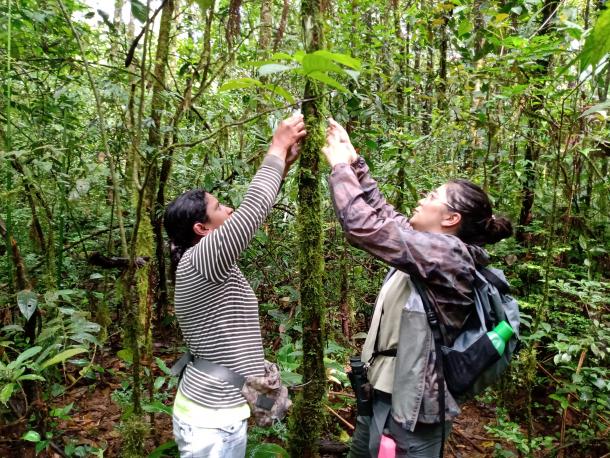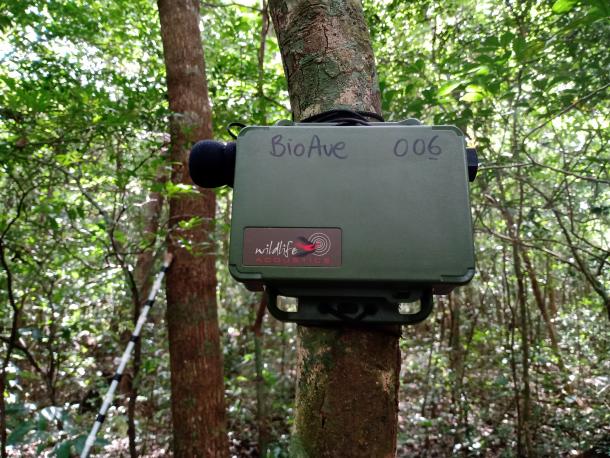
Parataxonomist Ana Cordoba (left) and Isabel Vargas (right) install a bioacoustic unit near Estación Leiva. Photo by Daney Chavarría.
The GDFCF/ACG BioAve program, which conducts research to better understand and conserve non-breeding habitat for migratory birds, is busy with its 2023 field season, including setting up the second year of monitoring for Wood Thrush, Hylocichla mustelina, using bioacoustics monitors. Wood Thrush are a species included on the Partners in Flight Yellow Watch List for birds at most risk of extinction. One goal of BioAve, which is led by Dr. Natalie Sánchez, is to develop an occupancy estimate of WOTH in the Caribbean rain forests of Área de Conservación Guanacaste (ACG). To conserve migratory birds such as the Wood Thrush, it is paramount to understand the habitats they prefer in the non-breeding grounds and potential threats to their populations. Part of this effort involves setting up bioacoustics monitoring devices, which record bird songs, in various parts of ACG. Another critical part of this project is to involve the parataxonomists in this work, in order to expand both their skill set and knowledge base, and help spread knowledge about biodiversity conservation into their communities. Master’s student Isabel Vargas, who is supported by GDFCF, has been working with parataxonomists to set up the bioacoustics units and teach them how to operate the devices and collect data. She is also measuring climatic and forest structure variables that will help explain patterns of Wood Thrush occupancy in these forests.
In December, Natalie and Isabel set up recorders at Estación Pitilla. In January and February, Isabel set up recorders and sampled vegetation in 5 biological stations: Quica, Leiva, Los Almendros, Llanura, and San Gerardo. According to Isabel, “In all the stations, the parataxonomists show interest in the project, and they help show me the trails, give me directions, and also, they learned about the project and how to use the recorders. In addition, we exchange information; they talk to me about their work, and I talk with them about the Wood Thrush project.” The parataxonomists have expressed great interest in learning more about BioAve and how they can be involved. Again, Isabel: “Ana Cordoba and Jorge Fernández, the parataxonomists at Estación Leiva, helped us a lot. They have shown interest in learning. They accompanied us and helped to install the recorders. I also taught Ana how to configure the recorders. They wanted to see the results, so I showed them what the thrush calls look like in the Raven Pro program, they were very happy to be able to recognize the call and that the recorders in Leiva have detected the wood thrushes.” With funding from the Conservation, Food & Health Foundation, the U.S. Fish and Wildlife Service Neotropical Migratory Bird Program, the Lynn Chase Wildlife Foundation, and individual donors, the BioAve project is supplying the parataxonomists working on this project with binoculars, a guide to birds in Costa Rica (in Spanish), and other equipment.

A bioacoustic monitor near Estación La Hacha. Photo by Isabel Vargas.